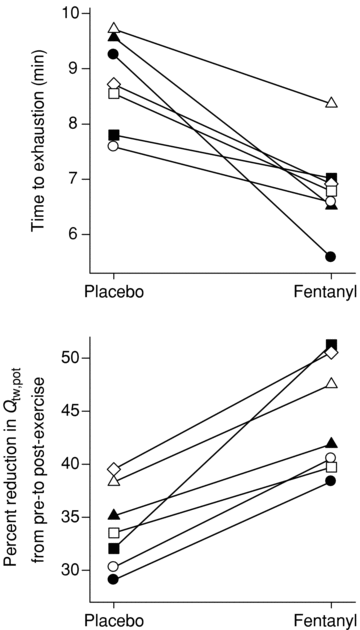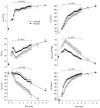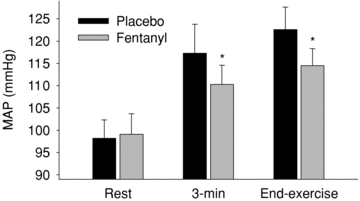Implications of group III and IV muscle afferents for high-intensity endurance exercise performance in humans
- PMID: 21878520
- PMCID: PMC3225681
- DOI: 10.1113/jphysiol.2011.213769
Implications of group III and IV muscle afferents for high-intensity endurance exercise performance in humans
Abstract
We investigated the influence of group III/IV muscle afferents on peripheral fatigue, central motor drive (CMD) and endurance capacity during high-intensity leg-cycling. In a double-blind, placebo-controlled design, seven males performed constant-load cycling exercise (318 ± 9 W; 80% of peak power output (W(peak))) to exhaustion under placebo conditions and with lumbar intrathecal fentanyl impairing spinal μ-opioid receptor-sensitive group III/IV muscle afferents. Peripheral fatigue was assessed via changes in pre- vs. post-exercise quadriceps force in response to supramaximal magnetic femoral nerve stimulation (ΔQ(tw,pot)). CMD was estimated via quadriceps electromyogram. To rule out a direct central effect of fentanyl, we documented unchanged resting cardioventilatory responses. Compared to placebo, significant hypoventilation during the fentanyl trial was indicated by the 9% lower V(E)/V(CO(2)), causing a 5 mmHg increase in end-tidal P(CO(2)) and a 3% lower haemoglobin saturation. Arterial pressure and heart rate averaged 8 and 10% lower, respectively, during the fentanyl trial and these differences progressively diminished towards end-exercise. Although initially similar, the percent change in CMD was 9 ± 3% higher at end-exercise with fentanyl vs. placebo (P < 0.05). Time to exhaustion was shorter (6.8 ± 0.3 min vs. 8.7 ± 0.3 min) and end-exercise ΔQ(tw,pot) was about one-third greater (-44 ± 2% vs. -34 ± 2%) following fentanyl vs. placebo. The rate of peripheral fatigue development was 67 ± 10% greater during the fentanyl trial (P < 0.01). Our findings suggest that feedback from group III/IV muscle afferents limits CMD but also minimizes locomotor muscle fatigue development by stimulating adequate ventilatory and circulatory responses to exercise. In the face of blocked group III/IV muscle afferents, CMD is less inhibited but O(2) transport compromised and locomotor muscle fatigability is exacerbated with a combined net effect of a reduced endurance performance.
Figures




References
-
- Adreani CM, Hill JM, Kaufman MP. Responses of group III and IV muscle afferents to dynamic exercise. J Appl Physiol. 1997;82:1811–1817. - PubMed
-
- Amann M. Central and peripheral fatigue: interaction during cycling exercise in humans. Med Science in Sports Exerc. 2011 DOI: 10.1249/MSS.0b013e31821f59ab. - DOI - PubMed
-
- Amann M, Calbet JA. Convective oxygen transport and fatigue. J Appl Physiol. 2008;104:861–870. - PubMed
Publication types
MeSH terms
Substances
Grants and funding
LinkOut - more resources
Full Text Sources
Other Literature Sources
Medical
Research Materials

